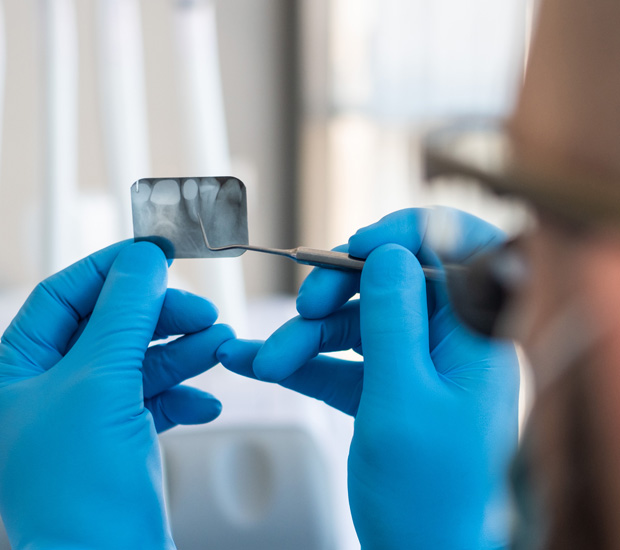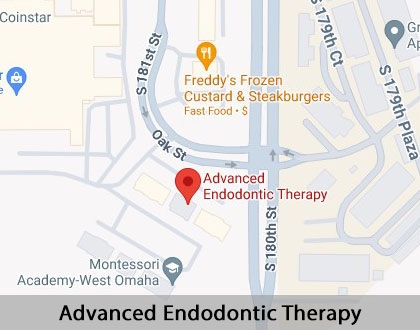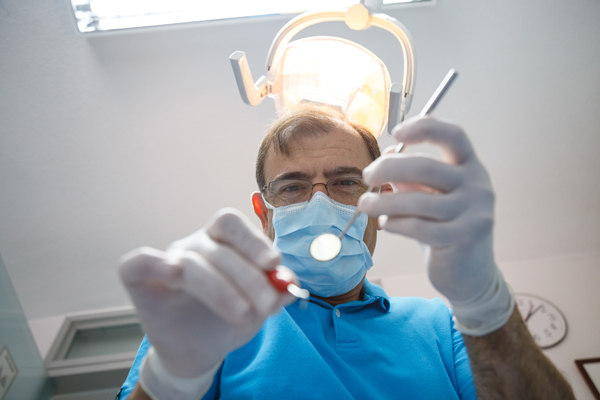What is Endodontics? Omaha, NE
Endodontics is a dental specialty that deals with diagnosing and treating causes of a toothache that stem from beneath the teeth and gums. Severe or persistent tooth pain can adversely affect a person's life and lead to serious health complications if left untreated. Fortunately, various endodontic treatments can provide patients with lasting relief from tooth pain and save their natural teeth.
If you have ongoing pain in your tooth or mouth, do not hesitate to seek professional care. Our team at Advanced Endodontic Therapy in Omaha and the surrounding area can help. Call us today at (402) 403-6988 to learn more about our services or schedule an appointment.
Tooth Anatomy
Endodontics is the branch of dentistry concerned with treating the dental pulp and tissues surrounding the tooth roots. The dental pulp is the connective tissue that lies at the center of a tooth beneath the layer of dentin. It consists of various types of cells, including fibroblasts, odontoblasts, macrophages, plasma cells, mast cells, and histiocytes.
The blood vessels, nerves, and connective tissues within the dental pulp provide the tooth with the nutrients it needs to function normally and healthily. They are also responsible for dentin formation, the calcified tissue that forms a protective layer around the tooth pulp. While the dental pulp is crucial to healthy tooth development, it is not necessary once a tooth has fully matured. If a mature tooth has infected pulp, we can remove the pulp safely to preserve the tooth.
“The dental pulp is the connective tissue that lies at the center of a tooth beneath the layer of dentin.”
Understanding Endodontics
Endodontic procedures can repair tooth tissues and treat complex causes of tooth pain, such as an infection. Endodontics aims to save a patient's natural tooth. According to the American Association of Endodontics, nothing looks, feels, or functions as well as a natural tooth. Endodontics primarily focuses on addressing problems that affect the tooth pulp, using special techniques to treat the tooth pulp and roots. Endodontists can treat damaged pulp or root tissues from tooth decay, abscess, injuries, or a crack that extends to the pulp tissue.
Damage from tooth decay or injuries can expose the dental pulp and increase the risk of infection. Endodontics can treat people struggling with pulpitis, which is inflammation of the dental pulp. There are two types of pulpitis, reversible or irreversible. Both types can cause pain and sensitivity, but irreversible pulpitis results in more severe symptoms. While reversible pulpitis is treatable with a simple filling, irreversible pulpitis will require endodontic treatment, such as root canal therapy.
Additionally, endodontic treatment can resolve pulp necrosis. Pulp necrosis is an irreversible condition that occurs when the dental pulp dies and is often the result of chronic pulpitis. This issue can lead to a dental abscess, which is the accumulation of pus within a tooth. Without endodontic treatment, a dental abscess can spread throughout the body and be potentially life-threatening. Root canal therapy can help save a tooth with pulp necrosis.
“Endodontic procedures can repair tooth tissues and treat complex causes of tooth pain, such as an infection.”
Root Canals
One of the most popular endodontic procedures is a root canal. Root canal treatment eliminates bacteria from an infected root canal. This procedure can prevent the tooth from being infected again and save a natural tooth from needing extraction. While a root canal can seem like an intimidating treatment, it is relatively painless. Patients will feel better after the treatment since it removes the source of their discomfort. The root canal process is similar to a routine filling and is completed within one to two appointments.
Before we can begin the root canal process, we will examine the tooth and take X-rays to see the shape of the root canals and whether the surrounding bone shows any signs of infection. Once we determine the treatment site, we will numb the area to keep the patient comfortable and place a dental dam to isolate the tooth and keep it clean during the procedure. Afterward, our endodontist will create an opening in the crown of the tooth and use small instruments to remove the infected pulp, bacteria, and decayed nerve tissue from the tooth chamber and root canals.
Once the root canals have been scraped and scrubbed, water or sodium hypochlorite will flush away the debris. We will also shape the space to make room for the filling. A biocompatible material fills the root canals while an adhesive cement seals them. In some cases, it may be necessary to wait a week before sealing the teeth.
“Root canal treatment eliminates bacteria from an infected root canal.”
Check out what others are saying about our dental services on Yelp: What is Endodontics? in Omaha, NE
Other Endodontic Procedures
Besides root canals, other endodontic procedures such as root canal retreatment, implant placement, and endodontic surgery are available to address oral pain and save a natural tooth. According to the American Association of Endodontics, root canals and other endodontic treatments are performed about 25 million times every year by skilled dental professionals to stop infections and save teeth.
Root Canal Retreatment
While root canal treatment can last for a lifetime with the proper care, a tooth may need retreatment in some cases. If a tooth has not healed properly after root canal treatment, it can become painful or reinfected months to years after the original procedure. This can be the result of narrow or curved root canals not being treated properly during the initial treatment, complex root canal anatomy, delayed restoration placement, or salivary contamination.
A tooth that has undergone root canal treatment can also develop new problems that require retreatment. New problems that can jeopardize a treated tooth include new decay, a new fracture, or a loose or broken crown or filling. This additional procedure can support the healing process and save a tooth from extraction. People experiencing pain or discomfort after receiving root canal treatment should speak with our team about the possibility of retreatment.
Endodontic Surgery
Endodontic surgery can detect small fractures or hidden canals that X-rays could not find during the initial treatment. Various endodontic surgical procedures can save a tooth from extraction. One of the most common endodontic surgeries is an apicoectomy or root-end resection. This procedure is beneficial for treating persistent inflammation or infection in the bony area around the end of a tooth after root canal therapy. During this procedure, the endodontist opens the gum tissue and removes infected tissue and, in some cases, the end of the root. After, a small filling seals the root canal.
Dental Implant Placement
If a tooth cannot be saved, a dental implant may be necessary. If an endodontist determines that a patient's tooth must be extracted, they will extract the tooth and place an implant. A dental implant will enable a patient to bite and chew properly, prevent tooth movement, and maintain a patient's appearance.
“Besides root canals, other endodontic procedures such as root canal retreatment, implant placement, and endodontic surgery are also available to address oral pain and save a natural tooth.”
Questions Answered on This Page
Q. What problems can endodontic treatment address?
Q. What happens during a root canal procedure?
Q. What other procedures can an endodontist provide?
Q. What should patients do after receiving endodontic treatment?
People Also Ask
Q. When is endodontic surgery needed?
Q. What causes tooth pulp damage?
Q. What can cause a tooth infection? What are the symptoms of a tooth infection?
Q. How should someone prepare for endodontic therapy?
Q. What is the difference between a dentist and an endodontist?
Managing Discomfort
The discomfort a patient feels after receiving endodontic treatment depends on their specific problem and its severity. Most patients will feel some minor discomfort after the local anesthetics wears off from an endodontic procedure. In the majority of cases, patients will be able to return home after their procedure and return to their normal activities the same day. Patients should wait until the numbing wears off before eating to avoid biting their cheeks or tongue. It is normal to feel sore for the next few days after endodontic treatment due to tissue inflammation.
Patients who have received more extensive surgery may experience some discomfort that is more severe and persists for longer. Our team may prescribe or recommend medications to help patients manage pain, fight infections, and aid the healing process. Patients must follow their endodontist's after-care instructions to ensure that their teeth heal properly. Some patients may have to wait to receive a restoration, such as a crown, to protect and fully restore the repaired tooth.
Patients should avoid chewing on the side of the treated tooth until the root canal procedure is completed with a permanent crown or filling. This precaution will help keep the tooth clean and prevent the fragile tooth from breaking before restoration is complete. After a root canal, patients should refrain from eating hard or chewy foods. Instead, we recommend eating soft foods such as eggs, yogurt, applesauce, and fish.
“Most patients will feel some minor discomfort after the local anesthetics wears off from an endodontic procedure.”
Frequently Asked Questions
Q. How successful are root canal procedures?
A. Root canals are highly successful procedures. According to a 2019 study in the Journal of Endodontics, the survival rate of teeth receiving initial root canal treatment was 90.85%. With the proper treatment, after-care, and maintenance, teeth that have undergone root canal treatment can last as long as natural teeth.
Q. What happens during an apicoectomy procedure?
A. Before an apicoectomy, the patient will receive a local anesthetic to numb the area around the treated tooth. During the procedure, the endodontist will make an incision in the gum to reach the root. Then, they will remove the root tip along with any surrounding infected tissue. Once root tip removal occurs, the endodontist will clean the root canals and seal them with a small filling to prevent future infection. The gum tissue is sutured so the jawbone can heal around the filling at the end of the root.
Q. What happens during dental implant placement?
A. Before dental implant placement, patients will first have their teeth, gums, and jawbone evaluated. The evaluation is to determine whether a patient has enough healthy jawbone to maintain an implant. If a patient is receiving an endosteal implant, an endodontist will make an incision in their gum to expose the jawbone. Then, they will drill a hole where the implant post will be inserted in the future. If a patient is receiving a subperiosteal implant, the implant post is placed on or above the bone. Once the dental implant is placed, it can take two to six months for osseointegration to occur. An abutment connects a dental restoration to the post when enough new bone growth occurs around the implant post.
Q. What is the structure and function of the tooth root?
A. The tooth root extends into the bone and holds a tooth in the right position. The root makes up about two-thirds of a tooth. It consists of various parts, including the root canal, cementum, periodontal ligament, nerves and blood vessels, and jawbone.
Q. What abnormal symptoms should I watch out for after receiving endodontic treatment?
A. While it is normal for a tooth to feel slightly different after endodontic treatment, some signs may indicate an issue that requires professional treatment. Abnormal symptoms may include severe and persistent pain or pressure, visible swelling inside or outside the mouth, allergic reactions to medication, uneven bite, or a loose temporary crown or filling. Patients experiencing any of these symptoms should contact our team immediately.
Start Feeling Better – Visit Us Today
By visiting us as soon as possible, our team can help get you the professional treatment you need. Instead of waiting around and allowing the symptoms to get worse, we can provide you with treatment options.
Definitions
Call Us Today
Severe tooth pain from dental pulp that is damaged or infected can adversely affect a person's quality of life. Fortunately, endodontic treatment can repair the tissues inside a person's tooth so they can improve the feel and function of their mouth. Our team at Advanced Endodontic Therapy can diagnose and treat complex endodontic problems to relieve your pain and preserve your natural smile. Call us today at 402-403-6988 to learn more about our services or schedule an appointment.
Helpful Related Links
- American Association of Endodontics. What’s the difference between a dentist and an endodontist? 2024
- Healthline. Cracked Tooth. 2024
- Medical News Today. What to know about pulpitis. 2024
- Medline Plus. Tooth anatomy. 2024
- Mouth Healthy. Root Canals. 2024
- National Library of Medicine. Dental infections. 2024
- ScienceDirect. Endodontic Surgery. 2024
- WebMD. What to Know About an Apicoectomy. 2024
About our business and website security
- Advanced Endodontic Therapy was established in 2008.
- We accept the following payment methods: Cash, Discover, MasterCard, and Visa
- We serve patients from the following counties: Douglas County, Dodge County, Lancaster County, and Sarpy County
- We serve patients from the following cities: Omaha, Benson, Florence, Bellevue, Fort Calhoun, Papillion, Lincoln, Bennington, Plattsmouth, Fremont and Elkhorn, Missouri Valley, and Council Bluffs
- Norton Safe Web. View Details
- Trend Micro Site Safety Center. View Details
Back to top of What is Endodontics?










